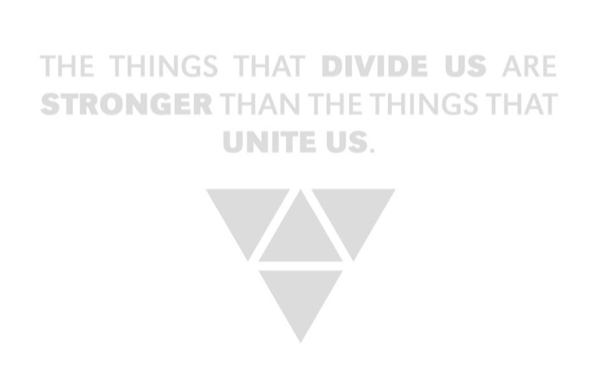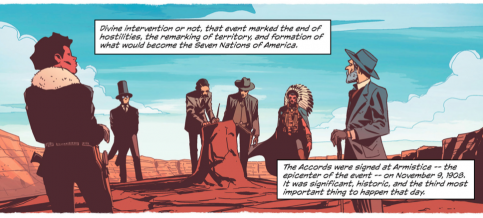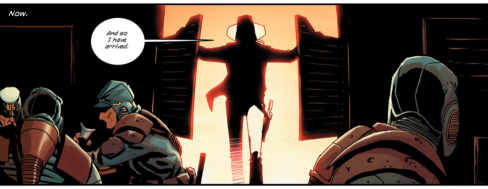
It’s always worth celebrating a new Jonathan Hickman comic book. (And we did, by making it “Pick of the Week” when it came out.) And while they are almost always rich, enjoyable comic book experiences, Hickman comics also tend to be very densely-packed and not afraid to challenge your literary intelligence. While “East of West” has sci-fi western trappings that tease our imaginations and contemporary visual style, there’s a lot of references and touchstones to keep track of in the writing and the art.
So, this is what I’m here for. I’ll be taking you through each issue of “East of West” and explaining references, tossing out theories, and keeping track of some of the major events and giving them context. My hope is that this will foster a discussion in the comments section, because lord knows I won’t catch nearly everything the book has to offer.
Keep in mind that we’ll be spoiling every issue, because I’m going to assume you’ve already read the issues. Why else would you be reading an annotations column on “East of West”?
With that said, let’s dive into the first issue of “East of West”, in which Death comes a-callin’ and the Horsemen of the Apocalypse find themselves down a band member at the end of the world.
East of West #1

Page 3, panel 6:
We see three “horsemen of the apocalypse” rising from the ground on a seemingly scorched world. The 4th horseman is missing in action. Traditional Christian mythology speaks of horsemen coming into the world as harbingers of the “last judgement.” They are iconography related to the end of the world in the book of Revelations. Scripture speaks of 4 different colored horsemen: white, red, black, and pale. These correspond to War, Famine, Conquest, and Death. Later, these characters will refer to themselves as War, Famine, and Conquest. This leaves “Death” as the missing horseman – who we know appears elsewhere (and in another time period) in this issue.

Page 7:
Though mostly a writer, Hickman enjoys employing his own unique sense of graphic design in his comic work. He favors simple shapes, attractive covers, and lots of minimalism in creating packages that are distinctly his. These simple designs usually have deeper thematic meanings and “East of West” is no different. Drawing on the Civil War, an alternate history of the divvying up of America, and the aforementioned disappearance of the 4th horseman, Hickman is exploring division in “East of West” and the ramifications of being divided.
It’s also an upside-down Triforce. Hey, cool!

Page 9, panels 1 & 2:
We’re introduced to Elijah Longstreet. James Longstreet was a Confederate general in the Civil War known as “Old War Hose” by Robert E. Lee. Some say that his efforts eventually cost the South the war and his political beliefs later in life had damaged his reputation with the confederacy. If we look deeper at what could just be a simple given name “Elijah”, it could be a reference to the prophet Elijah. Biblically, Elijah was one of the most revered prophets. It was believed that Elijah would one day serve to calm god’s wrath and restore order to divided nations. Seems kind of a fitting reference for Hickman’s apocalyptic story, right?
The names Elijah and Longstreet reflect the story of a confederate defector turned evangelistic prophet that Hickman describes here.

Page 10, panel 1:
Another biblical reference in “Joshua and the Amorites.” Joshua lead the battle of Jericho, in which it is said that god intervened and rained death on the Israelites. The point being that some believe that natural disasters or unlikely events are intervention through “acts of god”, while others believe that they are merely coincidence.

Page 10, panel 2:
These are “The Accords” – the fictional agreement formed by the leaders of the different nations that will make up the “Seven Nations of America” that we’ll see throughout Hickman’s story.

Page 10, panel 5:
Another biblical reference, of sorts. The Book of Revelation was written due to the compulsion of a voice or a force that was compelling the writer “John” to make proclamations about the end of the world. Not solely biblical though, as many religions and belief systems stem from the written word having been passed down from sources of faith, compulsion, and unexplainable forces. Here, several of the “Seven Nations” leaders are compelled to write “The Message”, a second book of Revelations, of sorts.

Page 12:
“Death” arrives at the Atlas saloon. A classic entrance for what Hickman is crafting to be an iconic character.

Page 17:
We are unsure just why at this point, but a group of powerful men from the “Seven Nations” stand before our “Death” character in a flashback as they attempt to kill him. They were led here by the man who would become the President (seen in the trenchcoat to the right of the saloon owner). Any theories as to what “Death” did to deserve it?

Page 21:
The Crow speaks of “The White Tower” as a place with “Nothing there but lies and the lying mouth that produce them.” Seems like the idea of corruption in Washington is no different in this alternate future? I also have to admit that I chuckled, because I immediately thought of Al Franken’s book Lies and the Lying Liars Who Tell Them. I hope that was an intentional reference.

Page 27:
The horsemen of the apocalypse throw the victims of their path of destruction into piles that form the familiar triforce shape when seen from above. A message to someone or simply a symbol of their reign of terror?

Page 28:
The White Tower. For practical purposes, this is the White House of the future. The president resides here. As you can see, it towers many times higher and wider than the next biggest building on this particular page.
And apparently it is not all that overwhelmingly well-guarded.

Page 29:
Here we see a Betsy Ross variant American flag hanging on the wall of the Oval Office. (Betsy Ross variant? Is that like an Alex Ross Dynamite incentive variant cover?) The Ross flag has 13 stars arranged in a circle to represent the original 13 colonies. One would consider that in this alternate timeline, the 50 states were not established, considering that “The Accords” were signed in 1908. However, there were plenty of states by that time. The Betsy Ross flag, never the less, is still an important symbol for the American Revolution and the United States’ independence regardless of time or place.
We also get a panel devoted to “E Pluribus Unum” (Or, “out of many, one”) – another reference to the idea of division vs. unity as a nation.

Page 34:
This is where “Death” is finally referred to by name, but there are several other references made in relation to the mythology surrounding “death” as an entity. He calls himself “Abaddon”, which is “destruction” in Hebrew and has been used in conjunction with the devil himself in Christian tradition. The “Reaper”, of course, is the classic image of death, wielding a scythe and wearing flowing robes. “Fool’s Bane”, as far as I can tell, is a one-handed mace weapon in World of Warcraft. And finally, “Grey Walker” doesn’t seem to be a direct reference to anything, though the words evoke the idea of the “pale rider” – a reaper-esque figure generally used in fiction to portray death as a mysterious and sometimes ghostlike assassin. Of course, there is a popular Clint Eastwood movie called Pale Rider which insinuates that Eastwood is acting as “Death” himself.

Page 36:
The issue closes on a map of the world Hickman has created. The regions are easily divided into certain peoples or ideaologies that traditionally make up the history of America. The Endless Nation, being the Native Americans that were pushed into the north & midwest. We see the “PRA”, which I assume stands for “People’s Republic of Asia”?
Before they part ways, Death tells The Wolf and The Crow to meet him at “The Golden Bridge” at the “Burning Plain.” Earlier, we see a version of San Francisco’s Golden Gate Bridge in which the support beams have been slightly altered to reflect architecture that appears to be of Oriental origin. The Burning Plain appears on the map to be a Midwest/Dust Bowl approximation. As we know it, the Golden Gate Bridge harbors the opening to the Pacific Ocean beneath it, so I can’t quite picture where the Burning Plain would be close enough to meet it. Perhaps this is an entirely different bridge?
Regardless, this is a nice way to end the issue. Who doesn’t love stories with maps in them? Hey, it worked for Tolkien.






